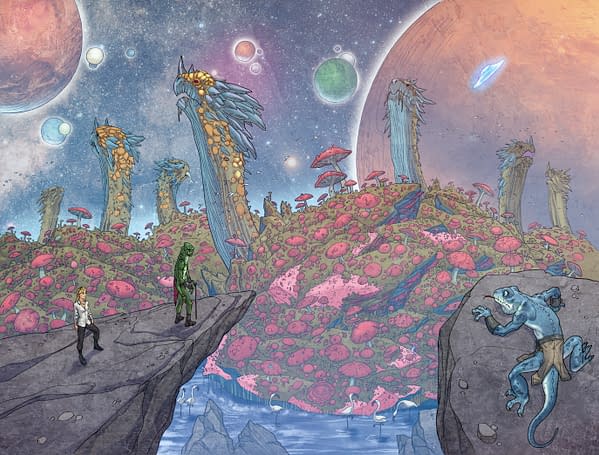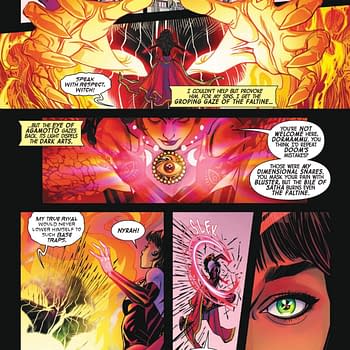Posted in: Comics, Recent Updates | Tagged: A1 Comics, alice in wonderland, Barnaby Bagenda, Comics, dave elliot, entertainment, hg wells, Ifansyah Noor, Jessica Kholinne, Rhoald Marcellius, Sakti Yuwono, Sami Basri, Sunny Gho, The Island of Doctor Moreau, The Weirding Willows, the wind in the willows, Titan comics
What If Wonderland Was A Shared Reality? Dave Elliot Talks Weirding Willows In The Bleeding Cool Interview
Dave Elliot has been an unrepentant maker of comics for many years, and co-edited the groundbreaking A1 Anthology with Gary Leach based on a creator-owned collective mentality featuring the works of Alan Moore, Neil Gaiman, and many more, and aside from bringing the A1 Anthology imprint back to life by Atomeka at Titan Comics in 2013 as an ongoing series, he's also been writing The Weirding Willows for the anthology for the past year. Now The Weirding Willows is breaking out into its first hardback edition as one of several planned volumes, and the collections contains extra features like essays, "Field Guide" information character sheets and hints at things to come.
The Weirding Willows has been with Elliot for a long time, if you consider the roots of his inspiration in excellent all-ages literature from the turn of the 20th century like Alice in Wonderland and The Wind in the Willows, or even the speculative fiction of H.G. Wells. In many ways, this is the story Elliot has always wanted to tell because it encompasses so many of the imagination-firing stories that have affected his life, and many of the minds of our generation.
But to get past the significance of The Weirding Willows as a meta-commentary on literary tradition and discuss the ways in which it tells a story about us, now, it's important to realize the ways in which Elliot has shaped these major works of literature into a combined universe and into one adventure-mystery story featuring an 18 year old Alice unraveling the sometimes dark secrets of her experiences in Wonderland. With the reader half a step ahead as they piece together the storylines and characters from familiar works, we explore an eerie shared imaginative space that's all too real for Alice. The Weirding Willows is, at heart, a fast-paced adventure story where all the strangeness and mentally teasing aspects of Wonderland are further explored.
Dave Elliot talks with us here at Bleeding Cool about this ever-expanding work and why he knows it's a significant contribution to comics and storytelling in the 21st century.
Hannah Means-Shannon: You speak in the introduction to Weirding Willows of the strange confluence of great works of imagination that sprang up in the 19th century that continue to inspire us today. Do you have any personal theories about why there was such an outpouring of fantastic fiction during that time?
Dave Elliot: I like to think that many of these authors were feeling an undercurrent of inspiration from the approach of the 20th Century. That mixed with that optimism was a little pessimism by some who might have a more realistic view of human nature.
Then there is the natural zeitgeist that influences people of any time. The more we all absorb the same information, the more we are likely to come to similar conclusions and, in the case of writers, similar ideas.
HMS: I always ask this question when it's obvious that a creator is fascinated by Alice in Wonderland… What is about Alice that captures your imagination so much and led you to make her, at age 18, central to this work?
DE: For many reasons Alice became the initial focus for this series, which may change as the larger story unfolds.
Like any writer approaching both Alice and Wonderland you tend to have already made up your mind who and what Alice really is. Is she insane, locked up in some insane asylum somewhere, or did she really travel to Wonderland and is that a real physical world to explore? I knew I wanted to follow the path of the latter even though there are many, including her own father, that think she should be in some sort of care.
Accepting she had actually gone to Wonderland I started to explore Alice's personality. What could possibly make a young girl so accepting of the things that she saw there?
I came up with two reasons and decided to use them both. The first is that she is autistic, mild but it has definitely not helped by the second reason… She has been raised since she was five solely by her father, Doctor Philippe Moreau. Moreau wasn't the same after his wife disappeared and that hasn't exactly created a closer bond with his daughter.
For me, Alice is also a character I can associate with myself. This Alice is intelligent but naïve. She accepts everything and everyone at face value. Alice will offer you the chance to be her friend, you may even get a second chance, but no one gets a third chance. I've been too trusting in my own life and it has come back to haunt me, Alice will follow a similar path.
HMS: What was it about Wind in the Willows that made you feel it should also be central to this complex interweaving of stories? I recall you mentioned to me at Wondercon that there were elements in the story that are often overlooked. Could you explain those elements to our readers?
DE: Sometimes it's the small things that can spark big ideas. There are two scenes in Wind in the Willows that rarely make it into any adaptation. One is when Mole and Ratty are out at night looking for Otter's missing son and they come across Pan playing his pipes. Pan indeed plays a role in this story but that is for a later date. The other is when Badger and Mole are exploring beneath Badger's house and Badger shows Mole the passages created by an advanced race of men long before the animals came to the woods. They're long gone now but the tunnels beneath the woods are still there, and more.
HMS: What do you think it brings to the story to include talking animals and develop a mythology about why some can speak and why some can't? What's it like writing animal characters versus humans?
DE: I think of the animals primarily as just characters that face their own problems in life. Animals are very intelligent and we really under estimate them so giving them a little boost and the ability to talk like us isn't (at least to me) pushing their evolution that far.
When you read the book you'll understand why some animals can talk and why others can't. There are other things going on in the background so if you see a species of wildlife not talking, don't think there isn't something else at play there.
I'm very concerned about the environment and the treatment of animals by humans in general so there will be a little of those issues raised as we go along but I'm trying to make sure I avoid preaching, this is entertainment after all.
HMS: You mention in the collection that you have, indeed, created some "new" linking characters to bring the stories together. Was that particularly rewarding for you, to find and develop just the right pieces for this puzzle that make the story uniquely your own, too?
DE: I could have created the Weirding Willows with entirely new characters. The world is new but just happens to be populated, at least in this time period, with characters that people are very familiar with. As you start to notice the changes and additions I've made in the characters from the source material, you will start to get a better picture of this world and how different my vision is to what we have been comfortable with.
Putting this together and layering the pieces over each other has and continues to be the most fun I've ever had creatively. Putting the pieces in place and fleshing out histories for the characters in a way that expands the connections each character has to the larger universe is something I could do all day.
Here's an example: with the Island of Doctor Moreau, H.G. Wells gave Moreau a companion and partner on the island whose main function was to save the 'survivor' and be a way for him to get information on Moreau without having direct contact himself. The reason 'Montgomery' was off the island at the beginning of the book was he was collecting animals for Moreau. Wells never bothered giving either Moreau or Montgomery a full name, let a lone character and history. That left plenty of space for me to fill in.
If Montgomery's primary function for Moreau is bringing in animals then I wanted to make that relevant to this story. I decided to make him a son of Doctor Doolittle and made his father's ability to talk to animals an inherited talent rather than something that was learnt. Now that makes it easy for Montgomery to pull in the animals that Moreau specifically requests.
HMS: I won't give too much away, but in this collection, there are definite "reveal" moments where readers suddenly realize "who" a character is and recognize their place in literature and in your story. When you, as a writer, realized those things, was it also a thrill for you? Is creating Weirding Willows one long chain of "Eureka" moments for you in creating this mosaic?
DE: I'm trying to write the characters as though they are new and that you don't need to have read the original books, but if you haven't you might now want to try them. The thrill for me is when I connect two characters and then a whole slew of story possibilities open up. I really feel as though I could write these books forever.
One great 'Eureka' moment was the Moreau/Montgomery Doolittle connection. It gave me the idea to connect Montgomery to another character that appears in the first volume, who also shares the 'Doolittle' abilities.
A couple of big 'Eureka' moments and events appear in the second volume that really shows the first big scope of what I'm trying to do.
HMS: You hint at a "grand plan" in the collection that's going to carefully stitch together these many fantasy worlds from great literature. Any hints you can give us about this?
DE: I've a rough path for the first 5 volumes and three spin-off series ideas if we can get that far. I can tell you that there is something that is a threat to not only these worlds but also the entirety of the universes they inhabit. Some of these characters will witness the end of our universe.
But that is a looooooooooooooooooooong way off. I have the ending in my head but I hope it's a cold day in Hell before I tell it.
HMS: I have an esoteric question for you. How do you think all these stories actually fit together in our imagination? Does storytelling, for you, exist as one thing somehow throughout time and cultures? Like The Dreaming in The Sandman, or like Jung's collective unconscious? And if so, how do you think that affects society?
DE: Storytelling has always existed and always will. It is part of our nature to visualize a written or verbal story or event. 100 people can visualize a single story 100 different ways but when they try explaining their vision to someone else that person thinks what is being described is the same thing as theirs but if visualized could well be something completely different.
I used to go on walks with kids where we'd talk about the possibilities of what I see and they see are two completely different things but because we've labeled them the same we agree on the description. You might see RED, I may well see BLUE, but we've both learned to call that color RED, even though what we see is different to one another. It sounds insane but it is a possibility.
I think many writers all watch the same TV shows, films, read the same books and comics, so they tend to come up with similar ideas at the same time because like computers they're analyzing the data all at the same time and so their creative results are often only a few degrees away from each other.
We are all connected we just don't realize it.
HMS: There's a playfulness and cuteness about some elements of characters, especially animals, in Weirding Willows, but also plenty of violence and "seriousness", too. How did you decide on the "tone" you wanted to establish in the story, and how would you describe it to readers?
DE: I actually think most comics are too violent these days. 'Grim and Gritty' is the norm for Marvel and DC when I don't think they should. I don't know if the genie can ever be put back in the bottle but until the industry gets creative and gives us stories that don't need to be so overly violent and sexualized I don't think the publishing side of the industry and truly grow.
For Weirding Willows, I wanted to use the tonal level of the first few Harry Potter books as a guide to what I was or wasn't going to do. You can depict violent acts without someone's entrails being pulled out. The first book has a character meet with a violent death, but you hardly see any blood. I think what is happening is self-evident so why take it further?
The core readership I am aiming for is 9 years old and up. That's not to say someone younger couldn't read it but it depends on the individual to handle it.
HMS: What was your thinking in establishing the helpful "Field Guide" pages for readers and how do you think this enhances reader participation in the story?
DE: The 'Field Guides' are there to give information on the character to the reader without slowing the story down. I think those pages enabled me to cover a lot more ground than if I was going to give that information in the story.
Plus, I wanted to acknowledge to the reader that I didn't originally create those characters and if they're interested enough to find out more I included the titles of the books they initially appeared in. Hopefully many people will go a read or reread those classics.
HMS: Can you tell us a little bit about the amazing artists you worked with on this book and how you came to collaborate with them?
DE: I've been working with the artists of STELLAR Labs since 2007 when they were part of the Singapore powerhouse studio Imaginary Friends Studios. IFS did all the art for Hercules, Caliber, City of Dust and created Freedom Formula for me at Radical. We pretty much all left at the same time.
STELLAR Labs is based in Jakarta and was set up by Sunny Gho one of the top colorists in the business.
The first artist on Weirding Willows was Barnaby Bagenda who had a wonderful line quality and who understood the original Arthur Rackham-esque quality about old stories that I was looking for. Unfortunately, he left the studio but instead I got to work with Sami Basri who had actually been my original choice for the series so I could myself blessed to work with both of them. Sami really loves fantasy and gets where I am going. His designs for the new characters appearing in volume 2 look stellar!
The main colorists are Sakti Yuwono, Ifansyah Noor and Jessica Kholinne. They give everything that nice watercolor feel the strip has that gives both a period feel and modern at the same time. The guys have been aceing everything they touch, X-Men, Superman, World's Finest, Power Girl, Voodoo, Teen Titans and their own creator owned strip, Carpe Diem, created by Rhoald Marcellius.
HMS: I hear there's been plenty of multi-media and adaptation interest in Weirding Willows. Is there anything you're at liberty to discuss about where all that might be headed?
DE: Yes there is lots of interest but I don't want to say anything until there's something worth saying. I have a lot I want to do with these worlds and characters so anyone I work with has to understand I don't just want to get a movie out there as quickly as possible. Weirding Willows is very much about character and story and I have a lot of both, not easy to jam into 90 minutes.
In the second volume, people will start to see the larger scope of the world and the first real hints to the first big story that culminates with volume 5. When I tell people where it's going and how it gets there they understand the scale and understand the potential for the project in every form of media.
The Weirding Willows Volume One will be available from Titan Comics on July 1st and the Second Volume issues of the comic will be appearing on ComiXology this autumn.
Dave Elliot will also be signing The Weirding Willows Volume One, A1 Comics, and Monster Massacre at Meltdown Comics in LA on July 2nd!
Hannah Means-Shannon is EIC at Bleeding Cool and @hannahmenzies on Twitter
























